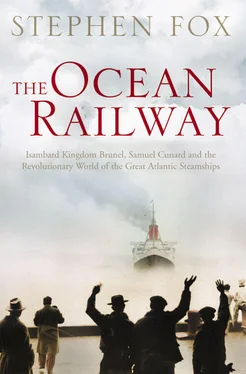By the late 1830s, twenty packetships were running from New York to Liverpool, twelve more to London, and sixteen to Le Havre. Every month, a dozen packets left New York for Europe and a dozen more arrived; an average of one ship every thirty hours, all year long, regardless of the wind and weather. The packets suffered occasional collisions and founderings at sea, but only two accidents caused any loss of life over the first two decades. The Albionof the Black Ball Line sank off Ireland in 1822, killing forty-six people, and four years later the Crisis of the Black X Line disappeared on a westbound run with her crew and about a dozen passengers. Those two disasters aside, the packets had compiled – for the time – a remarkable record of fast, safe, predictable transatlantic travel.
According to testimony from both sides of the ocean, Americans were building and running the finest sailing ships in the world. A London newspaper in 1834, after comparing the safety records of the New York packets and the British government’s mail ships, urged the Admiralty to buy American vessels. In 1836, a committeeof the British Parliament inquiring into the problem of shipwrecks presented evidence that American ships were better built than their British counterparts (and thus preferred by shippers and insurance agents), and that American commanders and officers were more educated and competent and American seamen more carefully selected, more efficient, and better paid – to the point that the best British sailors were defecting to American ships. American authorities could only happily agree. Matthew Maury, an American naval officer and one of the founders of oceanography, praised the New York packets in 1839 in language of patriotic but unchallenged hyperbole: ‘ For strength, safety, fleetness and beauty; and for a combination of all the requisites of a good ship, in such admirable proportions, no nation can boast of vessels, public or private, comparable to them.’
The packets became, in some measure, the victims of their own success. They had created the very notion of rapid technical improvement in transatlantic travel. Passengers came to expect bigger, faster ships every few years. The wind, however, could not be improved: it blew hard or not at all, from the east or west, but always beyond any human control. Sailing ships could only depart on a scheduled date. The time of arrival might then vary by weeks, depending on the ocean’s vagaries. Steam power extended the possibility of keeping a ship on schedule, or nearly so, at both ends of the passage. But Americans became so proficient and applauded at turning out wooden sailing ships that, as time passed, they – in complacency and inertia – kept building those ships for too long, far past their technological prime. In Great Britain, especially in Scotland, other men were about to take over the leadership of transatlantic shipbuilding.
Steam power drove both the Industrial Revolution and the progressive nineteenth century. Of all the thousands of inventions that have created the pervasive material modernity of the past two hundred years, the steam engine was the first cause, the prime mover and sine qua non. Unlike muscle power, it never tired or slept or refused to obey. Unlike waterpower, its immediate predecessor, it ran in all seasons and weathers, always the same. Unlike the wind, it responded tractably to human will and imagination: turning on and off, modulating smoothly from the finest delicacy to greatest force, ever under responsive control. ‘ It is impossibleto contemplate, without a feeling of exultation, this wonder of modern art,’ the Quarterly Review of London declared in 1830. After first transforming mining, manufacturing and transportation, from those bases the steam engine eventually reached into the smallest aspects of everyday life. Seen from the distant perspective of two centuries later, the great Steam Age looks like an unbroken, triumphal march.
Seen closer at hand, the application of steam power to any given field was a messy process overflowing with false starts and repeated, redundant discoveries. The most baffling aspect of inventing a steamboat, it turned out, did not involve the engine, fuel, boiler or hull. Instead it came down to the propelling mechanism, the essential driving link between the steam engine and the water. The challenge of how to contrive a harnessing device that would let an engine power a boat forward, even against winds and tides, had no obvious, inevitable solution. Many lone tinkerers in Europe and America tried to solve the puzzle and subsided in defeat. One such inventor worked out key practical breakthroughs and even built and ran an influential steamboat; but he was overwhelmed by unrelated forces beyond his ken, became discouraged, and died broke and unappreciated. Another pioneer took the work of this inventor and others without giving credit, later lied about it, and finally perjured and embarrassed himself; but he also thereby acquired great fame and fortune, and to this day retains a thumping historical reputation as the true father of steam navigation. The story has its ironies.
The steam engine and steamboat both emerged from a visible chain of invention: a series of innovators, aware of earlier work in the field and consciously building on it, adding and subtracting and thus moving the whole process forward by small increments until the machine ran right. The final, laborious success when ultimately achieved was descended from many parents, leading to bitter quarrels and lawsuits over who should get the credit and rewards.
For thousands of years, unconnected individuals had puzzled over how to control and use the power of steam. Nothing important happened until Thomas Newcomen started a chain of invention in 1712. An ironmonger in southwestern England, Newcomen made tools for the tin miners of Cornwall. As mines were dug deeper, they were flooded with groundwater, overwhelming any manual or horse-driven pumps. Newcomen invented a steam-powered mine drainer: a large horizontal beam, pivoting at the middle, linked to a water pump at one end and a vertical piston and cylinder at the other. Steam entered the cylinder at the bottom and drove the piston upward; at the top of the stroke, cold water sprayed into the cylinder below the piston condensed the vapour back into liquid form, creating a partial vacuum which pulled the piston back down to repeat the cycle. The engine worked – but was bulky, expensive, and inefficient. ‘ It takesan iron mine to build a Newcomen engine,’ the saying went, ‘and a coal mine to keep it going.’
Skip ahead to a classic moment in the history of modernity. In the winter of 1763-64, a Scottish instrument maker at Glasgow University was asked to repair a model of a Newcomen engine. James Watt, then twenty-eight years old, mended the model and started pondering the general problem of steam power, especially the obvious waste and inefficiency of the Newcomen design. He tried making the boiler surface larger, and placing the fire in the middle of the water supply, and even using wooden pipes and boilers (because they would conduct and lose less heat than metal components). One Sunday early in 1765, while walking across Glasgow green, Wattfinally got it: create a separate condenser so the cylinder could remain at essentially the same temperature throughout the cycle, saving time and fuel because no steam would be lost to condensation from entering a cold cylinder. ‘ I can thinkof nothing else but this machine,’ Watt informed a friend. ‘Write me…if any part of what you have to tell me concerns the fire-engine.’
For the next crucial step, moving from inspiration to application, Watt needed help. Beset all his life by poor health and severe headaches, timid by nature and easily discouraged, Watt dealt uncertainly with the world outside his workshop. ‘ Jamie isa queer lad,’ noted the wife of an associate. Matthew Boulton, a Birmingham manufacturer, offered to become ‘ a midwifeto ease you of your burthen’, as he put it to Watt, ‘and to introduce your brat into the world.’ Boulton had more experience than Watt in the metal industry, ready access to money, and many useful contacts. Watt joined Boulton as partners in Birmingham. With a patent obtained in 1769, and later extended, they essentially controlled steamengine technology for the next three decades. Watt and Boulton formed the first and most important of the many talent-meshing teams of engineer and entrepreneur that later propelled the Industrial Revolution.
Читать дальше












